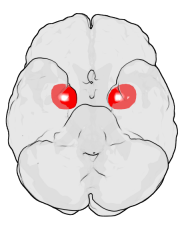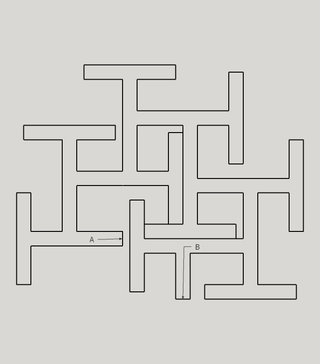
The amygdala is a paired nuclear complex present in the cerebral hemispheres of vertebrates. It is considered part of the limbic system. In primates, it is located medially within the temporal lobes. It consists of many nuclei, each made up of further subnuclei. The subdivision most commonly made is into the basolateral, central, cortical, and medial nuclei together with the intercalated cell clusters. The amygdala has a primary role in the processing of memory, decision-making, and emotional responses. The amygdala was first identified and named by Karl Friedrich Burdach in 1822.

Pavlovian fear conditioning is a behavioral paradigm in which organisms learn to predict aversive events. It is a form of learning in which an aversive stimulus is associated with a particular neutral context or neutral stimulus, resulting in the expression of fear responses to the originally neutral stimulus or context. This can be done by pairing the neutral stimulus with an aversive stimulus. Eventually, the neutral stimulus alone can elicit the state of fear. In the vocabulary of classical conditioning, the neutral stimulus or context is the "conditional stimulus" (CS), the aversive stimulus is the "unconditional stimulus" (US), and the fear is the "conditional response" (CR).

In cognitive psychology and neuroscience, spatial memory is a form of memory responsible for the recording and recovery of information needed to plan a course to a location and to recall the location of an object or the occurrence of an event. Spatial memory is necessary for orientation in space. Spatial memory can also be divided into egocentric and allocentric spatial memory. A person's spatial memory is required to navigate in a familiar city. A rat's spatial memory is needed to learn the location of food at the end of a maze. In both humans and animals, spatial memories are summarized as a cognitive map.

The Morris water navigation task, also known as the Morris water maze, is a behavioral procedure mostly used with rodents. It is widely used in behavioral neuroscience to study spatial learning and memory. It enables learning, memory, and spatial working to be studied with great accuracy, and can also be used to assess damage to particular cortical regions of the brain. It is used by neuroscientists to measure the effect of neurocognitive disorders on spatial learning and possible neural treatments, to test the effect of lesions to the brain in areas concerned with memory, and to study how age influences cognitive function and spatial learning. The task is also used as a tool to study drug-abuse, neural systems, neurotransmitters, and brain development.

The radial arm maze was designed by Olton and Samuelson in 1976 to measure spatial learning and memory in rats. The original apparatus consists of eight equidistantly spaced arms, each about 4 feet long, and all radiating from a small circular central platform. At the end of each arm there is a food site, the contents of which are not visible from the central platform.
Explicit memory is one of the two main types of long-term human memory, the other of which is implicit memory. Explicit memory is the conscious, intentional recollection of factual information, previous experiences, and concepts. This type of memory is dependent upon three processes: acquisition, consolidation, and retrieval.
Selective amnesia is a type of amnesia in which the sufferer loses only certain parts of their memory. Common elements that may be forgotten are relationships, where they live, and certain special abilities and talents.

The elevated plus maze (EPM) is a test measuring anxiety in laboratory animals that usually uses rodents as a screening test for putative anxiolytic or anxiogenic compounds and as a general research tool in neurobiological anxiety research such as PTSD and TBI. The model is based on the test animal's aversion to open spaces and tendency to be thigmotaxic. In the EPM, this anxiety is expressed by the animal spending more time in the enclosed arms. The validity of the model has been criticized as non-classical clinical anxiolytics produce mixed results in the EPM test. Despite this, the model is still commonly used for screening putative anxiolytics and for general research into the brain mechanisms of anxiety.

Environmental enrichment is the stimulation of the brain by its physical and social surroundings. Brains in richer, more stimulating environments have higher rates of synaptogenesis and more complex dendrite arbors, leading to increased brain activity. This effect takes place primarily during neurodevelopment, but also during adulthood to a lesser degree. With extra synapses there is also increased synapse activity, leading to an increased size and number of glial energy-support cells. Environmental enrichment also enhances capillary vasculation, providing the neurons and glial cells with extra energy. The neuropil expands, thickening the cortex. Research on rodent brains suggests that environmental enrichment may also lead to an increased rate of neurogenesis.

Conditioned place preference (CPP) is a form of Pavlovian conditioning used to measure the motivational effects of objects or experiences. This motivation comes from the pleasurable aspect of the experience, so that the brain can be reminded of the context that surrounded the "encounter". By measuring the amount of time an animal spends in an area that has been associated with a stimulus, researchers can infer the animal's liking for the stimulus. This paradigm can also be used to measure conditioned place aversion (CPA) with an identical procedure involving aversive stimuli instead. Both procedures usually involve mice or rats as subjects. This procedure can be used to measure extinction and reinstatement of the conditioned stimulus. Certain drugs are used in this paradigm to measure their reinforcing properties. Two different methods are used to choose the compartments to be conditioned, and these are biased vs. unbiased. The biased method allows the animal to explore the apparatus, and the compartment they least prefer is the one that the drug is administered in and the one they most prefer is the one where the vehicle is injected. This method allows the animal to choose the compartment they get the drug and vehicle. In comparison, the unbiased method does not allow the animal to choose what compartment they get the drug and vehicle in. Instead, the researcher chooses the compartments.

The rotarod performance test is a performance test based on a rotating rod with forced motor activity being applied, usually by a rodent. The test measures parameters such as riding time (seconds) or endurance. Some of the functions of the test include evaluating balance, grip strength and motor coordination of the subjects; especially in testing the effect of experimental drugs or after traumatic brain injury.
The study of memory incorporates research methodologies from neuropsychology, human development and animal testing using a wide range of species. The complex phenomenon of memory is explored by combining evidence from many areas of research. New technologies, experimental methods and animal experimentation have led to an increased understanding of the workings of memory.

Memory improvement is the act of enhancing one's memory. Factors motivating research on improving memory include conditions such as amnesia, age-related memory loss, people’s desire to enhance their memory, and the search to determine factors that impact memory and cognition. There are different techniques to improve memory, some of which include cognitive training, psychopharmacology, diet, stress management, and exercise. Each technique can improve memory in different ways.

The effects of stress on memory include interference with a person's capacity to encode memory and the ability to retrieve information. Stimuli, like stress, improved memory when it was related to learning the subject. During times of stress, the body reacts by secreting stress hormones into the bloodstream. Stress can cause acute and chronic changes in certain brain areas which can cause long-term damage. Over-secretion of stress hormones most frequently impairs long-term delayed recall memory, but can enhance short-term, immediate recall memory. This enhancement is particularly relative in emotional memory. In particular, the hippocampus, prefrontal cortex and the amygdala are affected. One class of stress hormone responsible for negatively affecting long-term, delayed recall memory is the glucocorticoids (GCs), the most notable of which is cortisol. Glucocorticoids facilitate and impair the actions of stress in the brain memory process. Cortisol is a known biomarker for stress. Under normal circumstances, the hippocampus regulates the production of cortisol through negative feedback because it has many receptors that are sensitive to these stress hormones. However, an excess of cortisol can impair the ability of the hippocampus to both encode and recall memories. These stress hormones are also hindering the hippocampus from receiving enough energy by diverting glucose levels to surrounding muscles.
Spontaneous Alternation Behavior (SAB) describes the tendency to alternate in the pursuit of different stimuli in consecutive trials, despite a lack of training or reinforcement. The behavior emerged from experiments using animals, mainly rodents, who naturally demonstrated the behavioral pattern when placed in previously unexplored maze shapes.

Carol A. Barnes is an American neuroscientist who is a Regents' Professor of psychology at the University of Arizona. Since 2006, she has been the Evelyn F. McKnight Chair for Learning and Memory in Aging and is director of the Evelyn F. McKnight Brain Institute. Barnes has been president of the Society for Neuroscience and is a Fellow of the American Association for the Advancement of Science, and foreign member of the Royal Norwegian Society of Sciences and Letters. She was elected to the National Academy of Sciences in 2018.
The hole-board test (HBT) is an experimental method used in scientific research to measure anxiety, stress, neophilia and emotionality in animals. Because of its ability to measure multiple behaviors it is a popular test in behavioral pharmacology, but the results are controversial.

In behavioral science, a T-maze is a simple forked passage used in animal cognition experiments. It is shaped like the letter T, providing the subject, typically a rodent, with a straightforward choice. T-mazes are used to study how the rodents function with memory and spatial learning through applying various stimuli. Starting in the early 20th century, rodents were used in experiments such as the T-maze. These concepts of T-mazes are used to assess rodent behavior. The different tasks, such as left-right discrimination and forced alternation, are mainly used with rodents to test reference and working memory.

The Cincinnati Water Maze (CWM) is a type of water maze. Water mazes are experimental equipment used in laboratories; they are mazes that are partially filled with water, and rodents are put in them to be observed and timed as they make their way through the maze. Generally two sets of rodents are put through the maze, one that has been treated, and another that has not, and the results are compared. The experimenter uses this type of maze to learn about the subject's cognitive or emotional processes.
Spatial anxiety is a sense of anxiety an individual experiences while processing environmental information contained in one's geographical space, with the purpose of navigation and orientation through that space. Spatial anxiety is also linked to the feeling of stress regarding the anticipation of a spatial-content related performance task. Particular cases of spatial anxiety can result in a more severe form of distress, as in agoraphobia.















